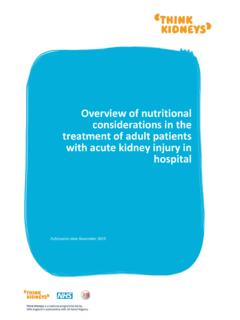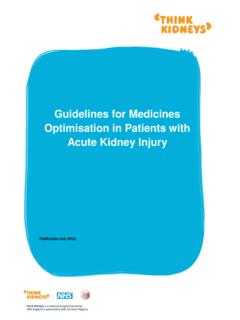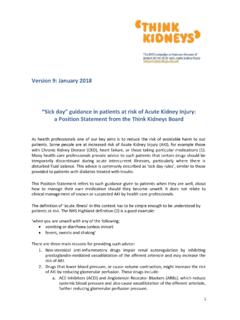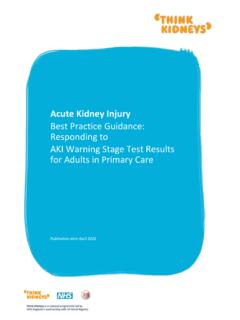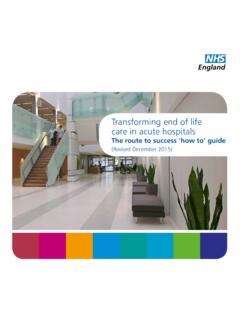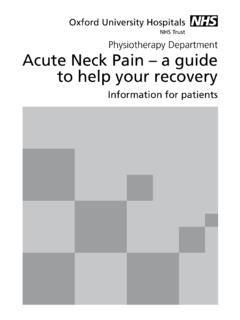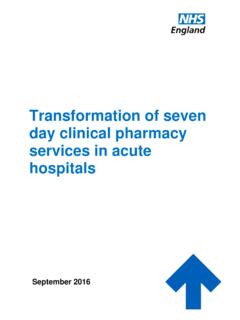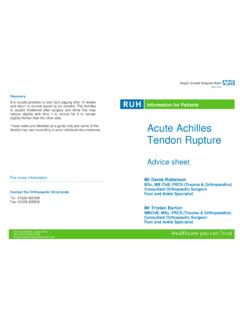Transcription of Guidelines for Medicines Optimisation in Patients with ...
1 Guidelines for Medicines Optimisation in Patients with acute Kidney Injury Publication March 2016 Guidelines for Medicines Optimisation in Patients with acute kidney injury 2 Guidelines for Medicines Optimisation in Patients with acute Kidney Injury Review date October 2016 Table of Contents Subject Page No 1. Introduction 3 2. acute kidney injury Medication Optimisation Pro forma 4 3. High risk medications and actions 5 4. Conclusion 15 5. Acknowledgements 15 6. Checklist for Medicines Optimisation in Patients with acute kidney injury (AKI) 16 To the best of our knowledge, the contents of this publication are in line with National Institute for Health and Care Excellence guidance relating to the management and treatment of acute kidney injury. Professional advice should be sought before taking, or refraining from taking, any action on the basis of the content of this publication.
2 We cannot be held responsible for any errors or omissions therein, nor for the consequences of these or for any loss or damage suffered by readers or any third party informed of its contents. The UK Renal Registry disclaims all liability and responsibility arising from any reliance placed on the information contained in this publication by you or any third party who may be informed of its contents. Guidelines for Medicines Optimisation in Patients with acute kidney injury 3 1. Introduction acute kidney injury (AKI) is the sudden loss of kidney function over a period of hours or days. Since the kidneys are one of the major excretory pathways for the removal of drugs from the body, this sudden loss of kidney function can have major implications for a patient s prescribed medication regime. The term nephrotoxic should be used with caution. Few medications truly have direct toxic effects on the kidneys, but several have the potential to impair renal function if used under certain circumstances, such as where the patient has a degree of chronic kidney disease in conjunction with hypovolaemia and acute illness.
3 Under these circumstances, continued use of these medications may further exacerbate an episode of AKI. The Think Kidneys Programme has taken the decision to avoid the use of the term nephrotoxic. In addition, many medications are cleared via the kidneys, so have the potential to accumulate during an episode of AKI. The result of this may be a further deterioration in kidney function, or there may be other adverse effects such as bone marrow or CNS toxicity. Hence it is necessary to review the use of these medications, and amend the doses appropriate to the level of the patient s renal function. When a patient is either admitted with AKI, or develops AKI during an admission episode, a thorough review of medication is required in order to: Eliminate the potential cause/risk/contributory factor for AKI Avoid inappropriate combinations of medications in the context of AKI Reduce adverse events Ensure that doses of prescribed medication are appropriate for the patient s level of renal function Ensure that all Medicines prescribed are clinically appropriate.
4 Points to note and questions to ask in the Medicines management of these Patients include: Which medications should be suspended? Which medications should not be suspended? Which medications may be used with caution? Are there any alternative therapeutic options? If a medication must be used, in order to minimise harm: Amend doses appropriate to the patient s level of renal function Monitor blood levels of drugs wherever possible Keep course of treatment as short as possible Discuss treatment with pharmacist/microbiologist Guidelines for Medicines Optimisation in Patients with acute kidney injury 4 Ensure appropriate information and advice is given on discharge: From the ICU to the ward From the ward to the GP (and care home if required) From the ward to the patient and their family/carers 2. acute kidney injury Medication Optimisation Pro forma In order to optimise the prescribing of medications to a patient with AKI, the following points should be considered: 1.
5 Is the patient receiving medication which may impair renal function? Contrast media ACE Inhibitor NSAIDs Diuretics Angiotensin receptor blocker Consider withholding these agents during an episode of AKI. 2. Medication Is the patient taking any other medications which could exacerbate AKI? Consider withholding them. Is the patient prescribed any medications where the dose needs to be amended in renal impairment? Amend medication doses appropriate to the patient s degree of renal impairment. In house Guidelines for drug use in AKI are recommended for example for. antibiotics, analgesia, contrast media, chemotherapy. 3. Educate the patient before discharge about which medications to restart and when, which Medicines to avoid etc. 4. Ensure comprehensive information on which medications to restart and when, is communicated to the GP or next care setting.
6 Guidelines for Medicines Optimisation in Patients with acute kidney injury 5 Other useful reference sources to facilitate dose adjustment in AKI include: Group of Medicines Suggested Guidelines Anti-retrovirals /HAART National Institute of Health HIV/AIDS Treatment Guidelines Chemotherapy North London Cancer Network Guidelines Mental Health The Maudsley Prescribing Guidelines General medications The Renal Drug Database General medications Manufacturers Summary of Product Characteristics 3. High risk Medicines and actions The following list of medications is not exhaustive. Remember to consider ALL medications including any usual long term medications. Remember to check medication history thoroughly and ask about over the counter preparations, herbal remedies/teas and alternative therapies. Check recreational use of drugs (cocaine, ketamine etc) as these have been implicated in rhabdomyolysis.
7 With reference to the table below, the three types of problem associated with the use of drugs in AKI are:- 1) effects on renal/fluid/electrolyte physiology 2) change in the side effect profile when renal function is reduced 3) direct action on the kidneys This format is therefore adopted in the following table. Guidelines for Medicines Optimisation in Patients with acute kidney injury 6 Drug Effects on renal/fluid/electrolyte physiology Change in the side effect profile when renal function is reduced Direct action on the kidneys Action in presence of AKI Analgesics NSAIDs / COX II inhibitors Altered haemodynamics within the kidney leading to underperfusion and reduced glomerular filtration acute interstitial nephritis (rare) Avoid Opioid analgesics Accumulation of active metabolites (especially morphine, pethidine and codeine) increased incidence of CNS side effects & respiratory depression Avoid XL / SR preparations.
8 Reduce dose and use short acting preparations wherever possible. Use opiates with minimal renal excretion fentanyl, oxycodone, hydromorphone Tramadol May accumulate leading to increased sedation, mental confusion and respiratory depression Reduce dose Avoid XL preparations Benzodiazepines Accumulation of drug & active metabolites leading to increased sedation & mental confusion Reduce dose & monitor for excessive sedation Antibiotics / Antifungals / Antivirals Aciclovir Accumulation leading to mental confusion, seizures. Crystal nephropathy. Reduce dose Beware if patient is at risk of dehydration - Encourage patient to drink plenty Guidelines for Medicines Optimisation in Patients with acute kidney injury 7 Drug Effects on renal/fluid/electrolyte physiology Change in the side effect profile when renal function is reduced Direct action on the kidneys Action in presence of AKI Aminoglycosides Ototoxicity Tubular cell toxicity Avoid if possible.
9 If use is unavoidable, reduce dose &/or increase dosing interval Monitor drug levels and renal function 2 3 times per week Amphotericin IV Fungizone Hypokalaemia Tubular cell toxicity Avoid rapid infusion Consider Ambisome preparation Co-trimoxazole Hyperkalaemia Crystal nephropathy Reduce dose. Beware if patient is at risk of dehydration - Encourage patient to drink plenty Fluconazole Accumulation leading to acute mental confusion, coma, seizures Reduce dose. Check for drug interactions that may be contributing to AKI, eg. consider withholding statins due to risk of rhabdomyolysis Ganciclovir IV Accumulation leading to neutropenia, anaemia and thrombocytopenia Crystal nephropathy Reduce dose Monitor renal function and full blood count Avoid rapid infusions Penicillins Accumulation leading to CNS side effects including seizures acute interstitial nephritis (rare) Glomerulonephritis Reduce dose Teicoplanin Accumulation leading to CNS excitation, seizures, & blood dyscrasias Reduce dose Monitor levels Guidelines for Medicines Optimisation in Patients with acute kidney injury 8 Drug Effects on renal/fluid/electrolyte physiology Change in the side effect profile when renal function is reduced Direct action on the kidneys Action in presence of AKI Tetracycline Accumulation leading to renal dysfunction, benign cranial hypertension, jaundice, hepatitis acute interstitial nephritis (rare)
10 Avoid Trimethoprim Increased risk of hyperkalaemia. Interferes with tubular secretion of creatinine leading to a rise in serum creatinine (without affecting actual GFR), which can make the diagnosis of AKI more difficult. Accumulation leading to hyperkalaemia (particularly with high doses), nausea and vomiting acute interstitial nephritis (rare) Avoid or reduce dose (particularly if patient is already taking an ACEI, ARB or spironolactone) Studies have shown that elderly Patients prescribed trimethoprim have a 12 x greater risk of developing life-threatening hyperkalaemia if already taking spironolactone, and a 7-fold increased risk of life-threatening hyperkalaemia, and a x increased risk of sudden death if already taking an ACEI or ARB. Valganciclovir Accumulation leading to neutropenia, anaemia and thrombocytopenia Reduce dose Monitor renal function and full blood count Vancomycin Accumulation leading to renal toxicity, ototoxicity acute interstitial nephritis (rare) Reduce dose / increase dose interval Monitor levels Antiepileptics (including drugs used for neuropathic pain) Phenytoin Risk of phenytoin toxicity if patient has low serum albumin levels acute interstitial nephritis (rare) Monitor levels Correct phenytoin levels for uraemia and low serum albumin or measure salivary phenytoin (if assay available)
